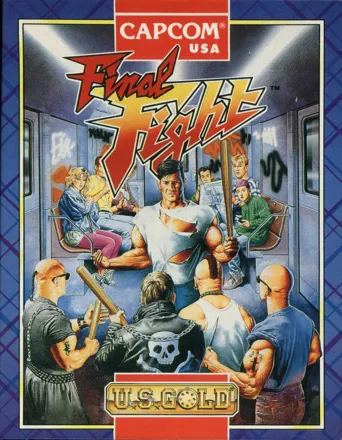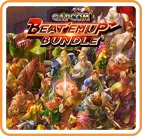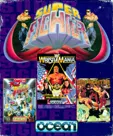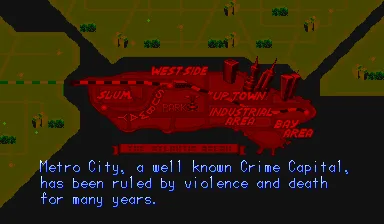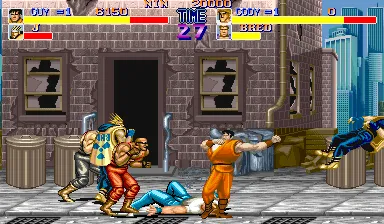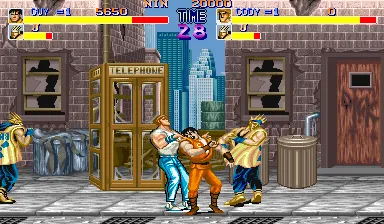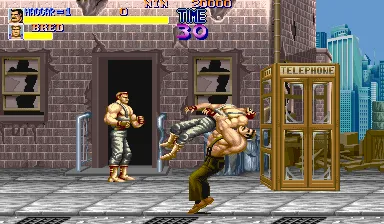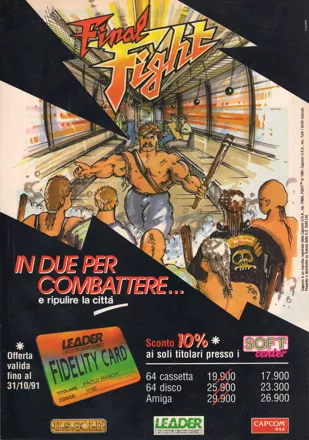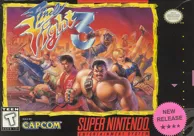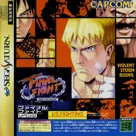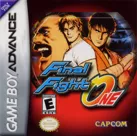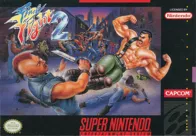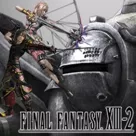Final Fight
-
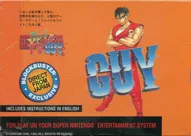 Final Fight
(1990 on
SNES, 2007 on
Wii, 2013 on
Wii U...)
Final Fight
(1990 on
SNES, 2007 on
Wii, 2013 on
Wii U...)
Description official description
The streets of Metro City are filled with criminals who are part of a gang called Mad Gear. Former wrestler and newly elected mayor Mike Haggar tries to do something about it, much to the displeasure of the Mad Gear Gang who kidnap his daughter Jessica. Only three people are brave enough to venture into the crime-infested streets and try to bring Jessica back.
Final Fight is a 2D side-scrolling fighting game. Taking on the role of either Cody, Guy, or the mayor Mike Haggar himself, you must advance through six areas of the city clearing out the gang infestation. You will have to cope with a variety of thugs, ranging from firebomb-throwing maniacs to behemoth wrestlers. To defeat these thugs, you have an arsenal of punches, kicks, throws, and jump kicks at your disposal.
The Sega CD port adds voice acting to the game's intro and ending cutscenes and also adds a time attack mode (beat up as many enemies as possible in a limited amount of time). This version can only display four enemies on screen at once. The C64 version can only display two enemies on screen at once. Then the SNES version is different enough to warrant its own entry.
Spellings
- ファイナルファイト - Japanese spelling
Groups +
Screenshots
Promos
Videos
Add Trailer or Gameplay Video +1 point
See any errors or missing info for this game?
You can submit a correction, contribute trivia, add to a game group, add a related site or alternate title.
Credits (Arcade version)
25 People (21 developers, 4 thanks)
| Planner |
|
| Programmer |
|
| Hard |
|
| Character Design (Object) |
|
| Character Design (Scroll) |
|
| Music / Sound |
|
| Special Thanks |
|
Reviews
Critics
Average score: 72% (based on 44 ratings)
Players
Average score: 3.8 out of 5 (based on 128 ratings with 5 reviews)
A bold attempt considering the circumstances but one that is ultimately lacking.
The Good
Amiga Final Fight features some pretty great graphics for a beat 'em up on this system. The sprites are actually from the arcade machine and haven't been custom re-drawn like the SNES port. Even with the reduced colour palette it still looks monstrous and considering the viewport on screen is smaller this makes the sprites appear even bigger. The sound effects are from the arcade game too, albeit at a bit of a higher pitch and clicker due to the Amiga sound format and they appear to have had a boost at around 10kHz for clarity. All are very meaty and satisfying.
The game plays very smoothly too. There's no real jerkiness anywhere (bar some slowdown) like other Amiga titles and there are lovely touches like the way bodies will bounce or slide when they hit the ground or the player does a little hop when they get punched by an enemy. The programming is watertight as there are no glitches anywhere and there's also some really clever stuff going on in realtime in order to load, move and scroll those huge graphics around, which is working the poor little blitter chip like a hungry slave.
The intro is incredibly impressive, which is pretty much arcade perfect and features an astounding piece of music which was chosen by the programmer himself from the Amiga demo scene.
The Bad
It's all just spread far too thin. The game has all the features of the original which look good on paper (all the levels, all the characters and a 2 player mode) but it means everything has had to equally take a hit. As such most of the player moves are missing and the enemy AI has been reduced to a basic pattern for just about all the baddies. It's playable to a point but the lack of variety from only having about 4 moves means it becomes monotonous very quickly. The SNES port made a couple of huge sacrifices in specific areas and used the space to cram in the rest to its best level, but the Amiga conversion almost equally skims the top off of everything. (Different systems though, so it's an unfair comparison).
The absence of any in game music makes the play feel even more sterile and bare although this is 100% down to US Gold not bothering to hire a composer to do any music for the game.
The thing I dislike most about this game is the fact that it could have been so much better, as the foundation is solid but it was ruined by US Gold only hiring a one man development team and giving him a ridiculously tight deadline of around 5 months to complete it in. No resources were provided aside from a bare arcade PCB board (which the programmer himself ripped the sprites from with a homemade ROM reader) and everything had to be written from scratch in Assembler language by pretty much just looking at how the arcade game played and trying to guess how it worked rather than having a proper code reference.
The Bottom Line
If you had never played the arcade game then Amiga Final Fight is a decent enough time in short bursts. It's fun in two player mode and at the end of the day there are far worse beat 'em ups for the system.
In saying that, if you were a fan of the coin-op you just can't ignore the glaring omissions. The sad fact is that if the programmer had been furnished with a labeled printout of the arcade source code (apparently the Speccy programmer had this), some sprite sheets and a more relaxed deadline, this probably would have been one of the all time great conversions. As it was, most of the time was gobbled up ripping sprites and writing the game code from nothing, so what we got was just as much as could be done in the time given.
Being an Amiga, you were never going to get an arcade perfect conversion due to the vast differences in hardware power between the arcade game and the Commodore machine, but if you put your burning love for the coin-op to one side it's really not a bad game if taken on its own steam. As a conversion though, it's sorely lacking.
Amiga · by Kitsune Mifune (4) · 2017
The Good
Final Fight cd is often praised for it's good music, extra introduction screens and being close to the arcade conversion. The introduction has spoken dialogues and extra animated screens that aren't in the arcade. The game has also a time attack mode where the object is to defeat as many baddies as you can. This mode has some new locations that fit the game very well.
The Bad
This "good" music are just plain audio tracks, and what is so special about that? Anyone can just record real music and put it on a disc. The audio tracks just fade out and start over and that can be real ugly to listen to especially in the real long levels like the bay area. The game is still heavily censored: there is no blood, roxy and poison's clothes are larger, the liquor is still absent, the thug that discovers his car in a bad condition still says: "oh my car" etc.
Most of the stuff is still missing, from the beginning you can tell those barrels are deleted and so it happens many times during play. This is just an incomplete arcade version.
The graphics may be close to the real final fight, it's colours are definitely not. Maybe the sega cd couldn't do any better, but I cannot bear to see these washed out colours any longer.
There is something wrong with the animation and the hit detection. For some reason I can't explain it simply does not play the same as the arcade version.
And finally my real complaint about this conversion: The introduction with spoken words is real nice but why didn't they hire real voice actors?? Haggar doesn't sound like a mighty wrestler but like a wimp! The voice of the villain also sounds like a goof. I am not very happy about that, it is a major disappointment as it just doesn't fit the gorgeous animated introduction.
The Bottom Line
If you want to enjoy the arcade game to it's full glory you still have to stick with the real arcade game. However, if you are a real final fight fan like me, I do recommend you to watch the enhanced intro and to try out the time attack mode.
SEGA CD · by Schutzstaffel88 (12) · 2014
Solid Port Of A 1980's Brawler
The Good
The Sega CD version retains many of the features that were cut out from the Super Nintendo ports due to memory limitations. The CD edition has a 2-player mode, the option to play as any of the three urban heroes and includes all the original arcade game levels.
Unique to the CD version is an original sound track, voice work during some of the intermission sequences and a special time attack mode.
It remains one of the few side-scrolling, brawler action games for the Sega CD with a 2-player mode. Their are also some nice options such as the ability to adjust the level of difficulty.
The Bad
The severe hardware limitations of the Sega CD, meant that the 1993 CD port can not perfectly recreate the quality of an older arcade game. It could not even match the graphic capabilities of the Super Nintendo.
Final Fight CD, even if it had been a perfect port, suffers from being an 1980's brawler game without many of the improvements seen in subsequent 1990s games in that particular genre. Sega's own Streets of Rage 2 offers playable characters with many more offensive and defense moves, which are much easier to execute them the limited, often more cumbersome controls found in Final Fight CD.
One of the more common problems with early brawler games was the nasty habit of the computer to pull some pretty dirty moves out of its programming. For example, when your character falls down, thugs or even bosses often gather around you, thus ensuring that you will take some serious damage.
Last, but not least, Sega apparently still felt the need to censor the game. The transgender-women thugs were allowed to stay, but with less revealing attire. Certain Mad Gear thugs, such as 'Sodom' were given different names and bits of profanity were also toned down.
The Bottom Line
Final Fight CD is a solid port of a 1980s, brawler arcade game. Of the 16-bit ports it is closer to the original arcade game in terms of the number of playable characters, levels, bonus rounds and overall basic game play, with a few nice little extras, such as a cool sound track and the ability to adjust the level of difficulty.
If you can get past the Sega CD hardware limitations and the petty censorship, then you are left with one of the best games released for the Sega CD and one of the few Sega CD games with a 2-player mode.
SEGA CD · by ETJB (428) · 2014
Trivia
1001 Video Games
The Arcade version of Final Fight appears in the book 1001 Video Games You Must Play Before You Die by General Editor Tony Mott.
Amiga port theme music
Jolyon Myers' theme music from the game's Amiga port is an original composition of his called Lost In Time, originally made for the 1990 Amiga demo/musicdisk Amazing Tunes II, which also had other tunes by Myers under his scene name The Judge (Final Fight credits him under that name rather than with his real name). While the actual compositions and samples are identical between both versions, the version used on Final Fight plays slightly faster than the original Amazing Tunes II version.
Amiga startup-sequence code reference
Amiga version programmer Richard Aplin included a humorous piece of text in that version's startup sequence, in which he dismisses the accomplishment of Ronald Pieket Weeserik's Dynamic Loading System, used in SWIV to load the game as it played without losing any speed. Aplin argues that others had written the same code trick before, but found it too unwieldy to justify its use in most circumstances - though it was on show in Final Fight.
Development
Capcom firstly designed Final Fight to be the sequel to Street Fighter named Street Fighter '89, but they changed their minds and decided to give the game a new name and start a new series. Akira Nishitani said in Retro Gamer 37:
"Our intention was to develop Final Fight" as an original game in its own right - and that's what we did. However, "Street Fighter" had such a high name value, we decided to make use of its recognition and changed the name to "Street Fighter'89" fof a game show where it was displayed. At the game show it received an excellent reception, proving even more popular than we could have hoped. But this really wasn't related to "Street Fighter". We'd made "Final Fight" as we'd intended - with a totally different and new world view, so once its popularity had been confirmed, we decided to go back to the original name."
Sales
According to publisher Capcom, Final Fight has sold 1.48 million copies worldwide since its initial release (as of June 30, 2016).
Version differences
- All home computer versions of Final Fight include a shot of the Mayor's daughter tied up in her underwear during the opening sequence, which was only seen in Japanese arcades (it was censored in Europe and America).
- The female gang members (Poison/Roxy, etc.) haven't had much luck appearing in the home ports of the game. All the Nintendo versions replaced them completely with male enemies (this includes the GBA remake, at least the US version) and while they appear in some rare ports they can only be found with edited clothing. Only the rare Japanese SEGA CD version shows them in their original form.
- In contrast to the SNES version of Final Fight, the U.S. version of Final Fight CD had less differences to the original Japanese version: the girl punks were given slightly longer clothes, blood was taken out, Jessica wears her red dress in the intro (she was stripped to her underwear in the arcade and Japanese versions), DamnD's name was changed to Thrasher, Sodom's name was changed to Katana, the "SEXY" graffiti from the restroom stalls in one level was removed, and the references to beer and whisky were removed.
Wrestling connection
The enemy Andore bears resemblance to a wrestler called Andre the Giant however Akira Nishitani in Retro Gamer 37 stated that he had a friend whose nickname was "Andre" and it was actually him who the characters in "Final Fight" were named after. Though, Akira also admitted that those characters do look like Andre The Giant.
The story of Mike Haggar also has a parallel with the story of former wrestler Jesse Ventura, who left the ring to become governor in Minnesota.
Easter eggs
Japanese version of the game is filled with many Easter eggs.
- When you smashed up a bucket and a drum, if you could hit the right button at the right time the items change into lump of gold or a diamond that are worth 10000 points each.
- On level 3 Edi.E - the boss spits out the gum. It is possible to pick it up. When your character has full energy, it gives you 42910 points which is the date of birth of Akira Nishitani (42nd year of Showa Era (1967), September 10th).
- If you complete the last level on one coin, you can see a special ending which in Japan was called the "gyudon" (translated means "beef bowl").
Bonus stages
There were many different ideas for the bonus stages. It was planned to have a crash bonus rounds like destroying a piano and a house as well as beating bad guys until they were buried in the ground up to their shoulders. Eventually all these ideas (some of them were even developed) were cut out.
Awards
- Commodore Format
- July 1993 (Issue 34) - Modern Classics: Beat-'em-ups (It's a Croaker!)
- November 1994 (Issue 50) – #2 & #5 The Bottom 10
Information also contributed by Alexander Michel, Cantillon, Depth Lord, Johnny "ThunderPeel2001" Walker, Perfil Falso, and Zovni.
Analytics
Identifiers +
Contribute
Are you familiar with this game? Help document and preserve this entry in video game history! If your contribution is approved, you will earn points and be credited as a contributor.
Contributors to this Entry
Game added by NeoMoose.
Arcade added by 666gonzo666. iPhone added by Sciere. ZX Spectrum added by Martin Smith. J2ME added by Deleted. SEGA CD added by Satoshi Kunsai. Sharp X68000 added by Terok Nor. Amstrad CPC, Commodore 64 added by Katakis | カタキス. Amiga, Atari ST added by The Ring Hawk.
Additional contributors: Terok Nor, Satoshi Kunsai, chirinea, Alaka, Martin Smith, Lance Boyle, Caelestis, CalaisianMindthief, Patrick Bregger, mailmanppa, FatherJack.
Game added October 4, 2001. Last modified March 28, 2025.


